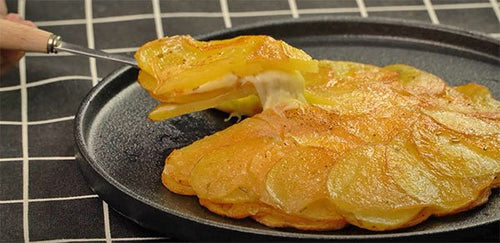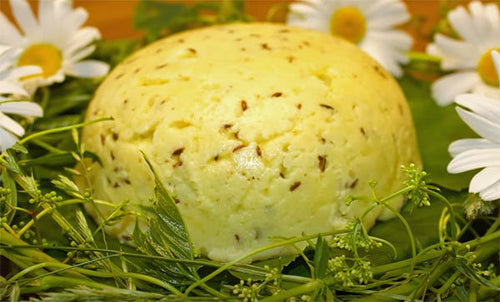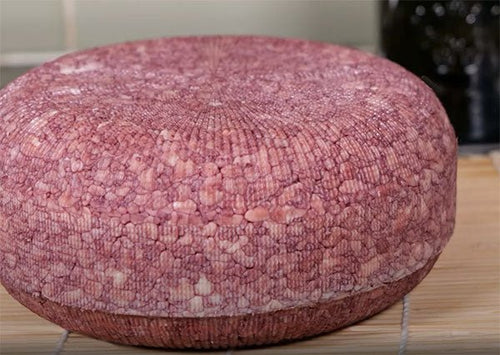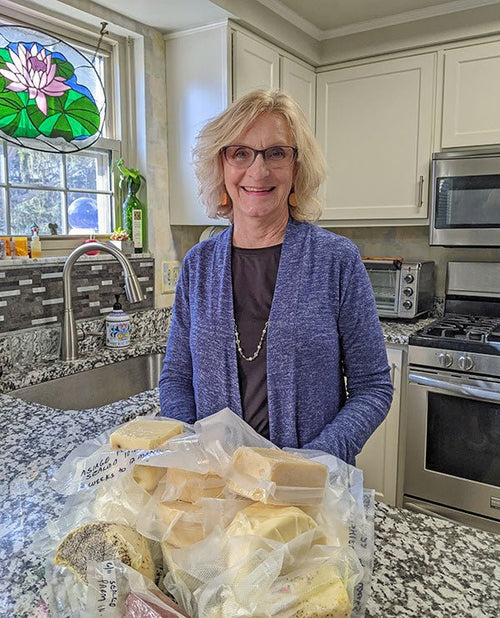Learn about different techniques and ways to work with curds, for both hard and soft cheese. An important aspect of cheese making is understanding how curds transform into different types of cheese, including the creation of delicious cheese curds. These fresh curds are not only a delightful snack but also showcase the nuances of curd handling and processing that can affect flavor and texture. After adding rennet, milk forms into a solid curd. Depending on the specific cheese making recipe, this curd will need to be cut, cooked and drained. How curds are handled will affect the final flavor, texture and appearance of your finished cheese.
The process builds upon techniques described in Draining Curds.
General Info
Handle Curds with Care
How curds are handled has a huge impact on the final quality of your cheese. If cut too small, the curds can lose moisture too quickly. If overcooked, the finished cheese can be dry and crumbly. When making cheese, take good notes on how you handle the curds so you are able to fine tune or duplicate techniques from one batch to the next.
No Curds Forming
Check the milk for curds below the surface to see if the curds have sunk. If no curds are forming, there may be an issue with your milk. You may want to visit our section on Milk.
Weak Curd and Loosing Butterfat
If the curds are not firm and there is a lot of butterfat being expelled, you may want to add calcium chloride for your next batch of cheese.
We recommend using ¼ tsp of calcium chloride for every gallon of store bought milk, or ½ tsp of calcium chloride for every gallon of raw milk. Before using, dilute the calcium chloride in ¼ cup cool, non-chlorinated water. Add the diluted calcium chloride solution when you begin heating the milk. Then, after adding rennet, allow the milk to set 3-5 minutes longer than usual before cutting the curds.
Signs of Contamination
If there are tiny holes through the curds and you notice a spongy feeling, the curds may be contaminated, possibly from the milk or equipment. These curds should be thrown away and not consumed.
When curds are spongy with holes in them, it is usually a coliform contamination problem. Coliform can be in anything from milking equipment to the pot used for make cheese. Coliform is more often a problem during hot dry summers or high humidity and rain.
Soft Cheese
Quick and Easy to Make
Many of our soft cheese starter cultures have rennet already added, so they are quick and easy to use. Our online cheese making recipes have detailed directions with step by step photos on how to make soft cheese at home.
Flavor of Homemade Cheese
The flavor from different types of milk and cream can very greatly. Fresh milk and cream is usually the secret to more flavor in soft cheese. Finding a local dairy to purchase milk and cream from can enhance the flavor of your finished cheese
Longer ripening times and higher temperatures can increase acid production and can change the final cheese from sweet to tangy.
Low Yield
Typically one gallon of milk with make approximately two pounds of cheese.
If you are getting a low yield, make sure the milk set long enough to form a firm curd. You should see either drops of whey or an entire layer of whey on the surface when the curd has fully set.
Another reason for low yield could be the milk. It might be too acidic from being stored too long before making cheese. This can cause a dry cheese and low yield.
Took a Long Time to Set
Even when soft cheese takes 24 hours to set, it should still be safe to eat. This is because the good bacteria, cheese cultures, you added are strong and able to dominate the fermentation process.
Note: Be sure to cover milk as it sets
Draining in Cheese Molds
When curds are ready to transfer into a cheese mold, the chord should be firm and slightly pulling away from the side of the pot with whey pooling above the curd mass.
If this is not happening and the curd has been setting at 68-72F for the specified time, the milk may have a low protein to calcium balance, especially if the milk is older. Try adding calcium chloride for your next batch of cheese.
Loose Curd at Bottom of Pot
If there is a firm curd at the top of the pot and a loose curd at the bottom, the starter culture was probably not mixed into the milk throughly. When adding starter culture, slowly stir the milk for 1-2 minutes.
Testing Rennet
Heat one cup of milk to 90F. Dissolve ¼ rennet tablet, or ¼ tsp liquid rennet, in 8 oz of cool non-shlorinated water and stir well. From this diluted rennet, take 2 tablespoons and add it to the heated milk. Stir gently from the bottom to the top for 30 seconds. If the rennet is working, the milk surface will begin to firm or form a slight film after two minutes. After six to ten minutes, it will have formed a curd that can hold a knife cut.
Drier or Acid Cheese
The ripening time and temperature can affect both flavor and texture of the finished cheese. A longer ripening time and/or higher temperatures will cause the ripening process to speed up and will produce a drier, more acidic cheese. A shorter ripening time and/or regular ripening temperatures will create creamier and sweeter cheese.
How to Store Soft Cheese
Fresh, soft cheese with a high moisture content, that is not meant to age, should be placed in a sealed container and stored in the refrigerator. Sanitized glass or plastic jars work well.
Adding Ash
Ash can be used in cheese making for several reasons.
- For aesthetics, it makes a lovely contrast to white goat cheese.
- When applied to the outside of a soft mold ripened cheese, it facilitates proper coverage of the mold.
- When making goat cheese, dusting the exterior of the cheese with ash will help to neutralize the acidity and produce a milder flavor.
Soft Cheese with Raw Milk
Creamier on Top
When using raw milk and a long ripening time, cream will rise to the top as the milk sets. This creates two separate products, sour cream on top, fresh cheese underneath. For more consistency in your cheese, mix these together.
Sour Flavor
If the flavor of your soft cheese is sour, the milk may have been too acidic before making cheese. Raw milk naturally contains bacteria for ripening. It typically needs less culture and ripening time than store bought milk.
If the milk is more than a day or two old, it may have developed too much acidity before you even added the culture.
Soupy Curd
If the final curd seems to be soupy when using raw milk, you might be having problems with late season lactation milk supply. Longer ripening times may help, the curds should not be transferred from the pot until whey begins to form on the surface and the curd pulls away from the sides of the pot.
How to Get a Goaty Flavor
For a more pronounced, goaty flavor, otherwise known as ‘buckiness’ simply keep the bucks closer to the girls, you will get the flavor.
Hard Cheese
Preparing for Pressing
When making hard cheese, starter cultures and rennet are added to milk, then the curds are cut and cooked to prepare for pressing. How curds are handled will vary of the type of cheese being made. Curd size, length of time being stirred and temperature cooking can each make a significant difference in the final cheese.
For more detail on handling curds, visit our online cheese making recipes detailed instructions with step-by-step photos.
How to Stop Curds From Rotating
When making cheese in a round pot, the curd may rotate slightly while being cut. This will not harm the curd, but it does make it difficult to cut evenly.
To reduce this movement, cut slowly, making an overall large cut. Then reduce the size of the cuts as needed.
Cutting Smaller Curds
When the curd needs to be cut into very small cubes, we usually make 1-2" vertical cuts, to start with, then allow the curd to rest before using a thin wired whisk to make the final cuts.
Uneven Curd Size
A good amount of care is needed to cut curds as evenly to the same size as possible. Larger curds will hold excess moisture and smaller ones will be too dry. This will create uneven ripening within the finished cheese. If the curds are very uneven, we suggest aging for a shorter period of time, because the cheese will have a higher moisture content.
Heat Curds Slowly
If curds are heated too quickly, they will develop a skin that will trap the whey inside and prevent adequate drainage. This will leave the final cheese with too much moisture and prevent it from aging properly.
Salting Curds
Both hard cheese and mold-ripened cheese require salt. It is used not just for flavor, but to slow the bacteria down and prevent an overly acidic cheese. Most cheese have about 1-1.5% salt by weight.
Iodized salt will interfere with bacterial ripening, so we suggest using one that is non-iodized. Most canning salts will work for making a brine soloution.
One of the biggest differences between our Cheese Salt and regular salt is the larger crystal size. When dry salting, the flake size of Cheese Salt ensures it does not dissolve too rapidly.
Adding Herbs or Spices
In aged cheese, we recommend using dried herbs such as Herbs de Provence, Caraway Seeds or dried peppers.
Mold is attracted to moisture in fresh ingredients and can cause contamination in cheese while being aged.
It is best to make additions to the curds, in multiple layers, when transferring them into cheese molds. This will place them well inside the outer edges of the cheese.












































































































































